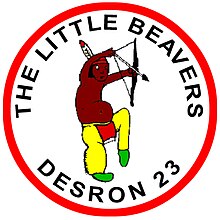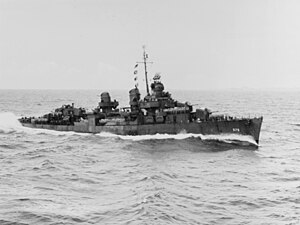Destroyer Squadron 23rd
The Destroyer Squadron 23 , or DesRon 23 for short , is a destroyer squadron of the United States Navy . DesRon 23 became known as The Little Beavers during the Pacific War . It was erected on May 11, 1943 and deactivated in February 1946. In April 1956 the Destroyer Division 231 was set up again and renamed DesRon 23 Little Beavers in December 1956 . It is based in San Diego , California and currently belongs to Carrier Strike Group 11 , which u. a. consists of the aircraft carrier USS Nimitz (CVN-68) , the guided missile cruiser USS Princeton (CG-59) and the Carrier Air Wing 11 .
history
The Destroyer Squadron 23 was set up on May 11, 1943 at the Boston Navy Yard . The first in command was Captain MJ Gilliam. When deployed, the destroyers USS Converse , USS Foote , USS Spence , USS Thatcher , USS Aulick , USS Charles Ausburne , USS Claxton and USS Dyson belonged to DesRon 23 .
On June 29, 1943, DesRon 23 , with the exception of the USS Aulick , became part of the 3rd US Fleet under the command of Admiral William F. Halsey and was mainly used for patrol services in the Southwest Pacific, as escorts and to combat targets near the coast during landings used.

On October 23, 1943, Captain Arleigh Burke became the commander of the DesRon 23 . In the following four months it was involved in 22 skirmishes in which a Japanese cruiser, nine destroyers, a submarine, several smaller units and about 30 aircraft were destroyed. Burke's constant order to his destroyers was: "Destroyers to attack on enemy contact WITHOUT ORDERS from the task force commander." . This time established the good reputation of the DesRon 23 and was the basis for being awarded a Presidential Unit Citation . DesRon 23 took part, among other things, in the naval battle at Empress Augusta Bay and the Battle of Cape St. George . The latter took place on November 25, 1943. A Japanese destroyer association, consisting of the transport destroyers Amagiri , Yugiri and Uzuki as well as the destroyers Onami and Makinami , was intercepted by the American destroyers and in a battle guided by radar it was possible to sink Onami , Makinami and Yugiri . The battle, which was rated as almost perfect surface action , ended the Japanese troop transports known as Tokyo Express by destroyer. After the liberation of the Philippines and operations off Okinawa , DesRon 23 returned to the United States and was awarded the Presidential Unit Citation on October 19, 1945 by Admiral Burke and Secretary of the Navy James Forrestal .
Presidential Unit Citation:
- For extraordinary heroism in action against enemy Japanese forces during the Solomon Islands Campaign, from 1 November 1943 to February 23, 1944 ... Destroyer Squadron Twenty-three operated in daring defiance of repeated attacks by hostile air groups, closing the enemy's strongly fortified shores to carry out sustained bombardments against Japanese coastal defenses and render effective cover and fire support for the major invasion operations in this area ... The brilliant and heroic record achieved by Destroyer Squadron Twenty-three is a distinctive tribute to the valiant fighting spirit of the individual units in this indomitable combat group of each skilled and courageous ship's company ...
On December 18, 1944, the destroyers of DesRon 23 fell into Typhoon Cobra (Halsey's Typhoon) as part of Task Force 38 . The USS Spence capsized after several attempts to take fuel from other ships had failed and the destroyer was therefore very high in the water, around 11 a.m. in the typhoon . 317 men went down with the ship. 24 men were rescued from ships that were nearby.
In February 1946, DesRon 23 was temporarily disbanded and the ships mothballed in Charleston , South Carolina as part of the reserve fleet .
On April 4, 1956, the Destroyer Squadron 23 was reactivated. The command was Captain EK Wakefield. On December 12, 1956, it was solemnly rededicated in Little Beavers by the Commander Cruiser Destroyer Force Rear Admiral Chester Wood . In April 1957, Captain HD Sturr took over the Destroyer Squadron 23 .
DesDiv 231
The DesRon 23 initially only included the Destroyer Division 231 with the destroyers USS Picking , USS Stephen Potter , USS Preston and USS Irwin . In May 1956, USS Irwin was replaced by USS Fechteler (DD-870) . From June 5, 1956 to November 1956, the DesDiv 231 belonged to the 7th US fleet and also carried out patrols in Formosa Street . On November 18, 1956, the DesDiv 231 returned to the home port of Long Beach. In 1957, the destroyer took a Good Will tour in the South Pacific and New Zealand. After that, patrols were again carried out in Formosa Street and sea maneuvers with the Navy of the Republic of China . On January 24, 1958 DesDiv 231 returned to the home port of Long Beach. In June 1958, the USS Stephen Potter was decommissioned without replacement. Trips to Japan, South Korea and Hong Kong followed. On March 27, 1959, he returned to the USA. As a replacement for the USS Stephen Potter , the USS Edson followed in May 1959 .
DesDiv 232
The Destroyer Division 232 , which emerged from the Destroyer Division 92 , ended its training trips on July 8, 1956 and began on August 16, 1956 with deployment trips in the Western Pacific. Including three months of patrols on Formosastraße . The Destroyer Division 232 consisted of USS Madox , USS Brush , USS Samuel N. Moore, and USS Herbert J. Thomas . The commanding officer was Captain HW Baker. DesDiv 232 returned to home port Long Beach on February 17, 1957. The next commander was Captain CB Carroll from March 1957. In 1957 the destroyers carried out a Good Will Tour to Australia, with the exception of the USS Samuel N. Moore, which was in the port of Pearl Harbor for repairs. There were also missions in the Mariana Islands and port visits in Japan. On March 1, 1958, DesDiv 231 returned to the Long Beach home port for shipyard overhaul and training. In April 1958 Captain SL Johnson took command of the DesDiv 232 On June 17, 1958 DesDiv 232 of Destroyer Squadron 23 assumed. In October 1958, there were again deployments in the western Pacific and ASWEX maneuvers with the Japanese sea self- defense forces . On April 22, 1959, he returned to Long Beach. In May 1959, Commander EM Glenn took command of DesDiv 232 .
mascot
DesRon 23's mascot is Little Beaver , a character from the Red Ryder cartoons by Fred Harmon. These cartoons were very popular with the destroyer crews during service during World War II. Due to the fast pace with which the destroyers' operations were carried out, the crews said they were busy as beavers . James Bowler, crew member of the USS Claxton , painted a picture on the side of a torpedo tube set of the destroyer showing Little Beaver shooting an arrow at Japanese Prime Minister Tōjō Hideki . Burke noticed the picture during an inspection on the USS Claxton . He liked it so much that he made it the logo for the entire DesRon 23 without a Tōjō .
units
Commanders
Commanders of Destroyer Squadron 23 since formation:
- MJ Gillian (May 1943 - October 1943)
- Arleigh A. Burke , later Chief of Naval Operations (October 1943 - March 1944)
- TB Duncan (March 1944 - July 1945)
- WC Ford (August 1945 - February 1946)
- Out of service (February 1946 - April 1956)
- EK Wakefield (April 1956 - April 1957)
- Harry D. Sturr (April 1957 - April 1958)
- JE Smith (April 1958 - May 1959)
- TH Morton (May 1959 - February 1960)
- TD Cunningham (February 1960 - July 1960)
- JL Kelly, Jr. (July 1960-June 1961)
- FE McIntire (June 1961 - September 1962)
- Robert A. Schelling (September 1962 - July 1963)
- CR Dwyer (July 1963 - December 1964)
- JC Hill (December 1964 - November 1965)
- LE Davis, Jr. (November 1965-July 1967)
- RE Spreen (July 1967 - July 1968)
- JJ Doak (July 1968 - January 1970)
- WH Rogers (January 1970 - May 1971)
- GM Neely (May 1971 - February 1973)
- Connolly (February 1973 - June 1974)
- Donald P. Roane (June 1974 - October 1976)
- Stuart D. Landersman (October 1976 - November 1978)
- ML Driver (November 1978 - March 1981)
- GC Flynn (March 1981 - April 1983)
- WH Kersting (April 1983 - June 1985)
- TA Barthold (June 1985 - May 1987)
- WE Kelly (May 1987 - March 1989)
- WR Schmidt (March 1989 - March 1991)
- RL Miller (March 1991 - December 1992)
- Thomas E. Utegaard (December 1992 - July 1994)
- KP Green (July 1994 - July 1995)
- Barry M. Costello (July 1995 - February 1997), later commander of the 3rd US Fleet
- PM Garrett (February 1997 - July 1998)
- CW Patten (July 1998 - July 2000)
- RS Riche (July 2000- July 2002)
- Charles W. Martoglio (July 2002 - September 2003)
- Gordan E. Van Hook, Bronze Star recipient (September 2003 - July 2005)
- Michael E. Smith (July 2005 - November 2006)
- Adam S. Levitt (November 2006 - May 2008)
- Troy A. Stoner (May 2008 - July 2009)
- James L. Autrey (July 2009 - December 2010)
- Jesse Wilson (December 2010 - May 2012)
- William J. Parker III (since May 2012)
literature
- Ken Jones. Destroyer Squadron 23: Combat Exploits of Arleigh Burke's Gallant Force , Naval Institute Press, 1997, Annapolis, ISBN 155-7-50412-1
- Theodore Roscoe: Destroyer Operations in World War II . United States Naval Institute, Annapolis, 1953, ISBN 978-0-87021-726-5
Individual evidence
- ↑ http://www.nytimes.com/1996/01/02/us/arleigh-a-burke-dies-at-94-naval-hero-of-world-war-ii.html
- ^ Evan Thomas, Sea of Thunder: Four Commanders and the Last Great Naval Campaign 1941-1945 . 2007 Simon and Schuster. ISBN 978-0-74-325222-5 , pages 71-72.
- ^ Theodore Roscoe: Destroyer Operations in World War II. P. 267
- ^ List of Citations Which Have Been Awarded Admiral Arleigh A. Burke, USN, (Ret) . Naval Historical Center. Retrieved December 6, 2011.
- ↑ Short biography. Retrieved March 1, 2020 .



















